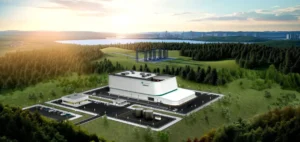Trawsfynydd, País de Gales está em discussões com NuScale para um sítio nuclear no limite da aldeia.
Uma rivalidade comercial
O Trawsfynydd está no centro das conversações com o governo galês para trazer pequenos reactores modulares (SMR) para o Reino Unido. O site está localizado no Norte do País de Gales. NuScale is ready to implement its SMR technology locally.
O sítio de Trawsfynydd poderia assim acomodar a tecnologia SMR, tal como o sítio Gwynedd. De facto, Gwynedd tem uma data alvo de 2027 para a construção. Em Trawsfynydd, existem três potenciais locais e têm um acordo com a Autoridade de Desmantelamento Nuclear (NDA).
Rolls-Royce SMR and Balfour Beatty assinaram memorandos de entendimento para planear a construção de reactores SMR. Estes seriam reactores de água leve pressurizada Holtec SMR-160. A empresa está a planear iniciar o processo de validação regulamentar do Reino Unido.
Uma tecnologia a ser implantada
NuScale argumenta que a sua tecnologia SMR VOYGR já está em desenvolvimento. Tudo o que resta é implementá-lo nos locais. Tom Mundy, Presidente da VOYGR, afirmou:
“Pensamos que estamos bem posicionados para poder avançar. Não é como se tivéssemos de desenvolver a tecnologia novamente e depois avançar com os projectos”.
De acordo com NuScale, o governo tem interesse em apoiar a tecnologia SMR como parte da equação energética global do Reino Unido. O desenho do VOYGR 12 pode acomodar até 12 módulos de fornecimento de energia NuScale. A produção bruta total ascende então a 924MWe.
O módulo de potência NuScale é também um reactor de água pressurizada para gerar vapor. A troca de calor integrada numa única unidade gera 77MWe. É o primeiro SMR a receber a aprovação do projecto da Comissão Reguladora Nuclear dos EUA.






















